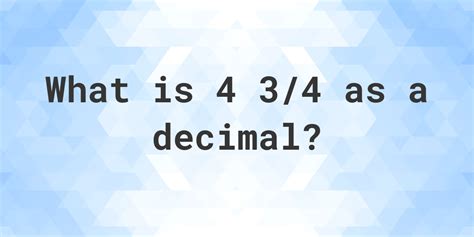4 3 4 As A Decimal
Kalali
Apr 03, 2025 · 4 min read

Table of Contents
4 3 4 as a Decimal: A Comprehensive Guide
The expression "4 3 4" isn't a standard mathematical notation. To understand what it could represent as a decimal, we need to consider the possible interpretations. This ambiguity highlights the crucial role of clear notation in mathematics and programming. Let's explore several scenarios and how they translate into decimal form.
Understanding the Ambiguity: Different Interpretations of "4 3 4"
The lack of operators (like +, -, *, /) between the digits makes "4 3 4" open to multiple interpretations. We can examine several possibilities:
1. Concatenation as an Integer: 434
The simplest interpretation is that "4 3 4" represents the integer four hundred and thirty-four. This is likely the most common understanding if no other context is given. As a decimal, this is simply 434.0.
2. Mixed Number: 4 3/4
This interpretation assumes that "4 3 4" represents a mixed number, where '4' is the whole number part and '3/4' is the fractional part. To convert this mixed number to a decimal:
- Convert the fraction to a decimal: 3/4 = 0.75
- Add the whole number part: 4 + 0.75 = 4.75
This is a common representation used in many contexts, especially in measurements and calculations.
3. Base-3 Representation: 434₃
It's possible "4 3 4" could represent a number in a different number system (base). A common choice would be base-3, but it's important to note that base-3 only uses digits 0, 1, and 2. The digit '4' is invalid in base-3. To clarify, this interpretation is incorrect if we strictly adhere to base notation. However, for illustrative purposes let's assume it was a hypothetical base using 0-4 digits (although not a standard base):
- Convert to base 10: (4 * 3²) + (3 * 3¹) + (4 * 3⁰) = 36 + 9 + 4 = 49
This demonstrates how changing the base fundamentally alters the decimal representation. A proper base-3 representation would need different digits, making this interpretation less likely.
4. Repeating Decimal: 4.343434...
Another potential interpretation could involve a repeating decimal. "4 3 4" might implicitly represent the number 4.343434... This repeating pattern can be converted to a fraction using the formula for repeating decimals:
Let x = 4.343434...
100x = 434.343434...
Subtracting x from 100x:
99x = 430
x = 430/99
Converting this fraction to a decimal using long division or a calculator: x ≈ 4.343434...
This interpretation requires careful consideration of the context to avoid ambiguity.
Advanced Interpretations and Contextual Understanding
The ambiguity of "4 3 4" highlights the importance of mathematical notation and precision. To properly understand and convert any numerical expression to decimal form, we need to account for the following:
- Explicit Operators: Always use operators (+, -, *, /) to specify mathematical operations between numbers. The absence of operators leads to multiple possible interpretations.
- Number Systems (Bases): Specify the base if it's not base 10 (decimal). Subscripts are commonly used to indicate the base (e.g., 101₂ for binary, 1A₁₆ for hexadecimal).
- Decimal Points: Use a decimal point (.) to clearly separate the whole number and fractional parts.
- Context: The context in which "4 3 4" appears significantly influences its intended meaning. Consider the field (mathematics, programming, measurement), units, and surrounding text.
Practical Applications and Examples
Let's illustrate these interpretations within practical scenarios:
Scenario 1: Measurement
Suppose you are measuring the length of a piece of wood. "4 3/4 inches" is a perfectly clear and unambiguous measurement. This translates directly to 4.75 inches in decimal form, making it straightforward for calculations and comparisons.
Scenario 2: Programming
In programming, "434" would generally be interpreted as an integer. Different programming languages might handle fractional parts differently. If you needed to represent 4 3/4, you would use a floating-point data type and explicitly write it as 4.75 or 4 + 3/4 depending on the language.
Scenario 3: Scientific Notation
In scientific or engineering contexts, "4 3 4" could, in principle, be interpreted as a number written in a non-standard scientific notation. However, it's important to note that scientific notation employs a standard format with an exponent. A proper example would be 4.34 x 10².
Avoiding Ambiguity: Best Practices in Notation
To prevent misunderstandings, follow these best practices when writing numerical expressions:
- Use standard mathematical notation: Employ clear operators and parentheses to indicate the order of operations.
- Specify the base: If you're working with a number system other than base 10, explicitly state the base using subscripts.
- Clarify repeating decimals: Use a bar notation (e.g., 0.3̅) to indicate repeating digits.
- Be consistent: Maintain consistent notation throughout your work.
Conclusion: The Importance of Clear Communication
The ambiguity of "4 3 4" underscores the critical need for precision and clarity in mathematical notation. While several interpretations are possible, we should always strive for unambiguous representations to avoid confusion and ensure accurate calculations and communication. The preferred interpretation would be dependent upon context, emphasizing the necessity for clear communication to avoid misinterpretations. By adhering to standard mathematical conventions and using precise notation, we prevent these ambiguous situations and foster better understanding in quantitative fields.
Latest Posts
Latest Posts
-
16 9 Oz Is How Many Ml
Apr 04, 2025
-
What Is 1 1 4 In Mm
Apr 04, 2025
-
14 C Is What In Fahrenheit
Apr 04, 2025
-
How Many Feet In 90 Inches
Apr 04, 2025
-
How Many Inches Is 90 Centimeters
Apr 04, 2025
Related Post
Thank you for visiting our website which covers about 4 3 4 As A Decimal . We hope the information provided has been useful to you. Feel free to contact us if you have any questions or need further assistance. See you next time and don't miss to bookmark.
